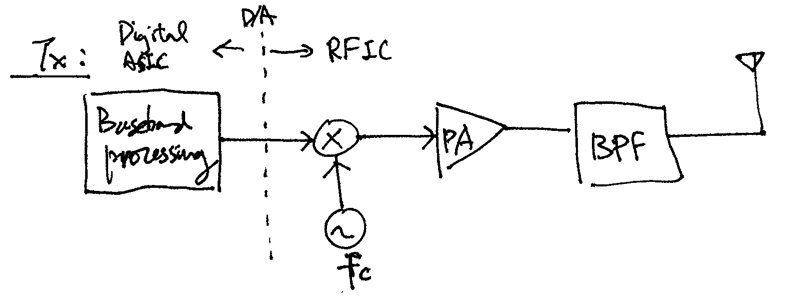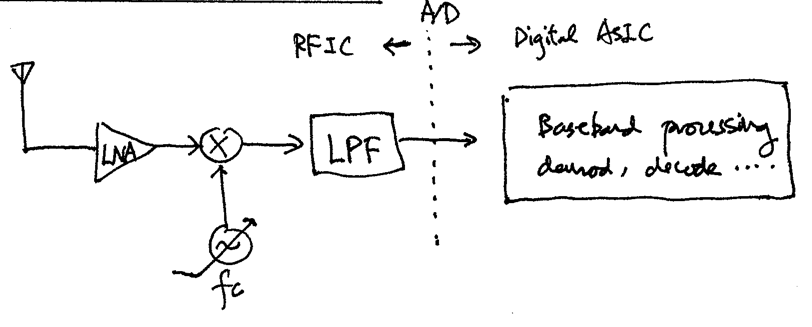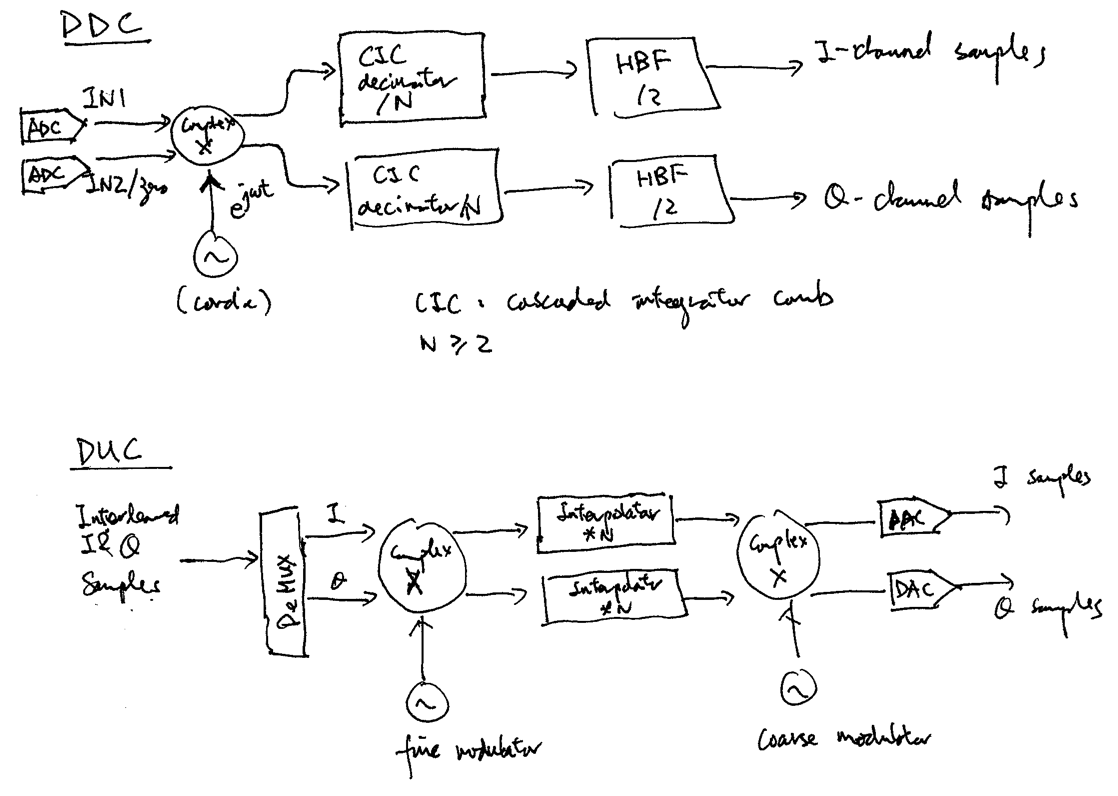1. Introduction#
1.1. Typical Radio Architectures#
1.1.1. Transmitter (TX):#

1.1.2. Direct down conversion receiver (RX):#

1.1.3. Superheterodyne receiver (RX):#

1.2. Software-defined Radio (SDR)#
Replace the “digital ASIC” components above by more programmable implementations, such as FPGA and general purpose CPU/GPU
In some more recent SDRs, the RF frontends are also made programmable to various degrees
Advantages: Flexible, shorter development time, highly reconfigurable (cognitive radios), high-speed implementation possible with FPGAs, …
Disadvantages: More expensive, higher power consumption, …
Popular SDR software development platforms: GNU Radio, MATLAB/Simulink, Labview, …
1.3. USRP Radios#
USRP stands for “Universal Software Radio Peripheral”
A collection of relatively low-cost, high-performance SDRs developed by Ettus Research
A USRP radio generally consists of a “motherboard” and a “daughterboard.” For some older USRP radios (such as the N2xx series and X3xx series), the daughterboard is interchangeable. For most newer USRP radios, such the B-series, E-series, and some of the newer N-series and X-series radios, the “dautherboard” is intergrated and thus can’t be changed.
A daughterboard typically contains an RF frontend with programmable mixers (carrier frequency) and amplifiers (gains)
The motherboard typically contains high-speed ADCs, DACs, an FPGA, and other interfacing and controlling circuitry to communicate with a general purpose host PC via USB, Ethernet, or PCI bus
One may program the FPGA on the motherboard to perform all IF and baseband processing
Alternatively the more “software-defined” approach is to have the FPGA programmed to perform digital frequency mixing (the mixers in the daughterboard have only a finite set of mixing frequencies; hence need to do fine-frequency mixing digitally), up/down conversion, filtering, and transfer of digital samples to the PC. All baseband processing is done by software in the host PC. We will employ this latter approach here.
1.4. USRP N210 Radios1 used in class#
1.4.1. Motherboard#

DAC/ADC resolution: 16/14 bits
Maximum transfer rate to/from host PC: 25 M complex samples/s (16-bit) or 50 M complex samples/s (8-bit)
Digital up/down convertors:
Needed to reconcile the differences between host sampling rates and ADC/DAC sampling rates
Host sampling rates should be selected carefully to work with various rate conversion operations and filtering in DDC/DUC

1.4.2. Daughterboards#
SBX:
2 quadrature RF chains: one for TX/RX and one for RX only (RX2)
Each RF chain has its own LO and frequency synthesizer; hence capable of supporting full-duplex operation
Programmable TX & RX amplifier gains: 0 - 31.5 dB with 0.5 dB steps
Analog bandwidth: 40 MHz (TX & RX)
Noise figure: 5dB typical
Tunable frequency range: 400 MHz - 4.4 GHz
TX power: 30 - 100 mW typical
CBX:
Same as SBX, except having frequency range from 1.2 - 6.0 GHz
Basic TX and RX:
No RF chain, serves as a simple interface between motherboard and external RF frontends (I & Q channels)
Analog BW: 250 MHz
Can be used (via direct connection to antenna and Nyquist zone sampling) as a low-sensitivity RX frontend around the FM band
1.5. UHD#
UHD = USRP Hardware Driver
A set of C++ APIs for controlling USRP radios and pushing/pulling samples to/from them
Newer versions of UHD also provide C and Python APIs
Newer versions of UHD also contain RF Network-on-Chip (RFNoC) APIs that support block-level programming of FPGA IP blocks on some of the newer USRP radios, such as X3xx/4xx and N3/4xx
We will use the basic C++ UHD APIs throughout the course
1.6. GNU Radio#
A software platform for users to build SDR applications
Construct signal flow graphs that link source, processing, and sink blocks together to implement SDR applications
Main components:
A scheduler that controls and implements signal and data flows among various blocks along signal flowgraphs
Driver APIs for most commercially available SDR hardwares
A very large collection of pre-defined source, sink, and processing blocks
Three levels of programming available:
GNU Radio Companion: GUI signal flow graph IDE
Python: Build signal flowgraphs and other GUIs
C++: Build source, sink, and processing blocks
Although we will NOT use GNU Radio in this class, I suggest everyone learn it because GNU Radio is a great tool for developing SDR applications.
Why not use GNU Radio as our teaching platform?
We will study physical-layer (PHY) communication and signal processing techniques/algorithms that are used to implement SDRs. We will definitely learn better by implementing the algorithms from scratch.
I believe learning the software plumbings that build SDRs is also very important. GNU Radio is great but it hides most of the plumbing stuff.
Eliminate the significant overhead of learning how to build processing blocks in GNU Radio and work with the GNU Radio scheduler.
1.7. References and further reading#
- 1
Jeffrey H. Reed. Software radio: a modern approach to radio engineering. Prentice Hall Professional, 2002. ISBN 0-13-081158-0.
- 2
GNU Radio Project. GNU Radio website. URL: https://www.gnuradio.org/about/.
- 3
Ettus Research. UHD information website. URL: https://kb.ettus.com/UHD.
- 1
Unfortunately, Ettus Research has retired the N210 series. Nevertheless, the N210 radios we have are fully functional and perfect for class purposes.
